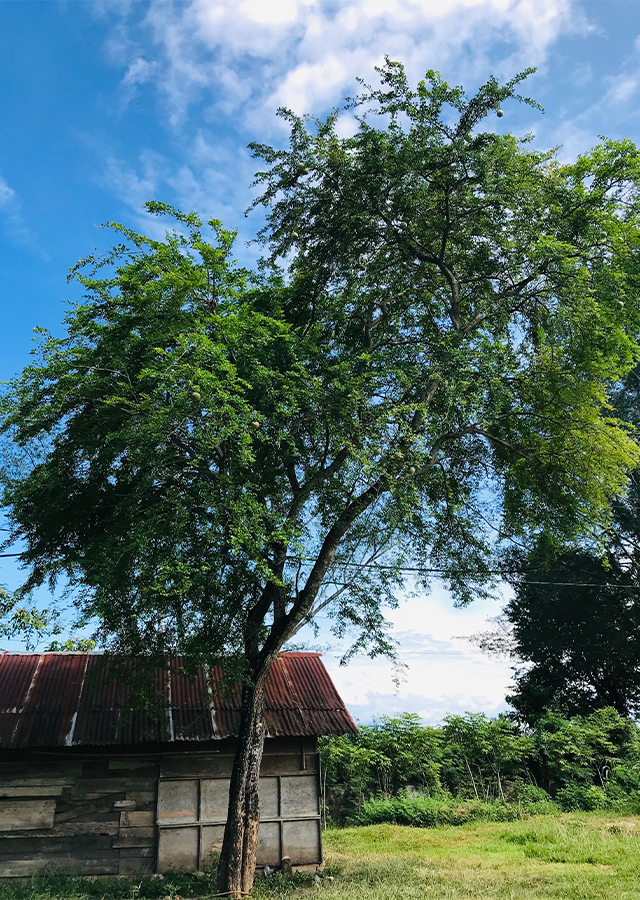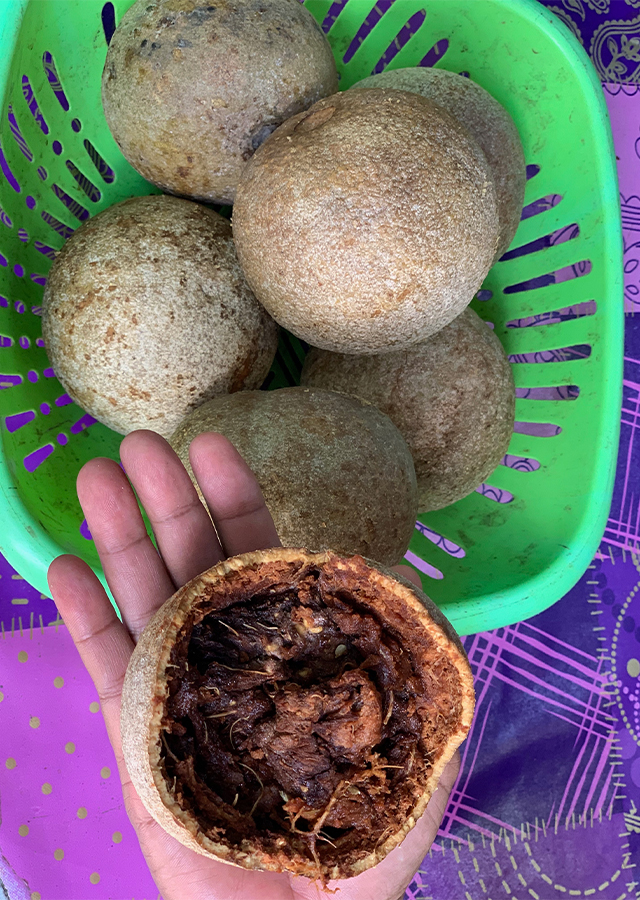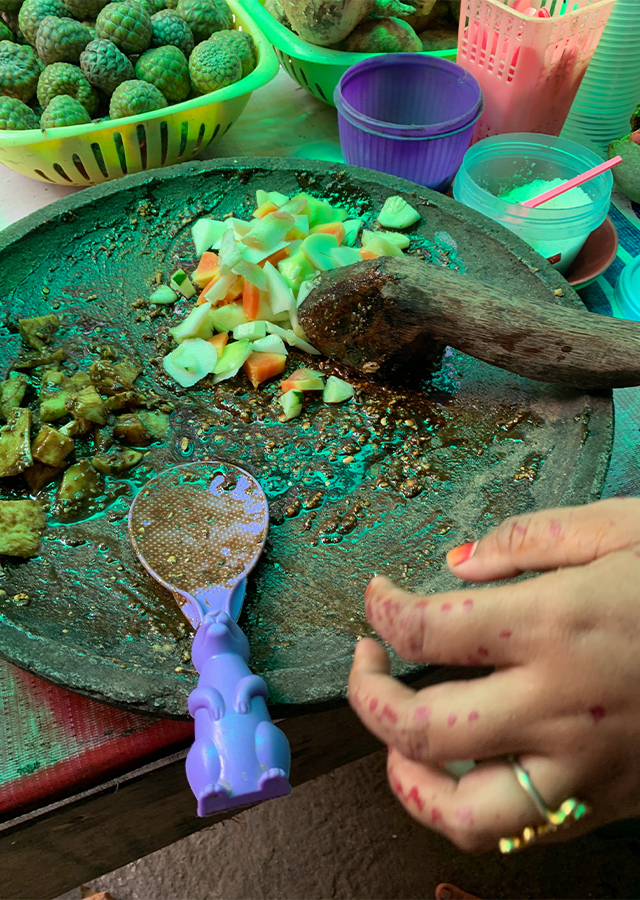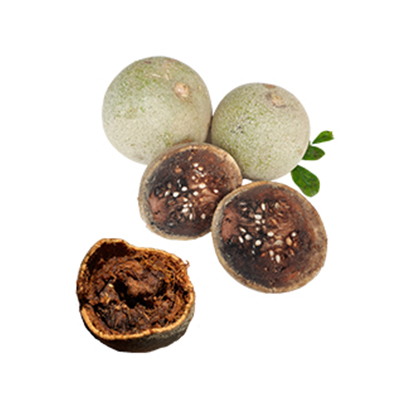Wood Apple
Limonia acidissima L.
Rutaceae
Location in our garden
Orchard



Synonym
Limonia ambigua DC.
Limonia curvispina Miq.
Limonia dulcis J.F.Gmel.
Habitus
Trees. A small to medium sized, thorny, deciduous perennial tree, growing up to 6–15 m high
Part Used
Leaves
Bark
Fruit
Growing Requirements
Full Sunshine
Habitat
Forest
Overview
Wood apple is a true multipurpose tree, gathered both from the wild and also cultivated for its edible fruit, plus its wide range of medicinal and other uses. It occurs naturally in India, Sri Lanka, Burma and Indo-China, where it is limited to the drier regions, cultivated in villages and parks throughout its natural range, and in Malaysia and Indonesia (Java, Bali). Trees grow slowly and will not produce fruits until the 15th year or later.
Vernacular Names
Mu ping guo (Chinese), Olifants appel (Dutch), Citron des mois (French), Elefantenapfel (German), Feronia rimonia (Japanese), Belinggai (Malaysia), Kawista (Java)
Agroecology
It thrives in a monsoonal or seasonally dry tropical climate, and found on a wide diversity of soils from sea level to 450 m altitude. Best adapted to light soils and is tolerant to drought and mild water-logging. Mean annual temperatures in range 20-29 °C, and mean annual rainfall is in the range 800-1,200 mm, prefers a pH in the range 5-6.
Morphology
- Barks - ridged, fissured and scaly and there are sharp spines: 3/4 to 2 in (2-5 cm) long on some of the zigzag twigs.
- Leaves - alternate, obovate, 7.5-12.5 cm long, dark-green, leathery, often minutely toothed, blunt or notched at the apex, are dotted with oil glands and slightly lemon-scented when crushed.
- Flowers - dull-red or greenish, 1.25 cm wide are borne in small, loose, terminal or lateral panicles. Terminal or axillary inflorescences.
- Fruits - round to oval, 5-12.5 cm wide, with a hard, woody, grayish-white, scurfy rind about 6 mm thick. The pulp is brown, aromatic, resinous, astringent, with numerous small slimy seeds.
- Seeds - 5-6 mm long, white, hairy, with thick, green cotyledons, germination epigeal
Cultivation
Propagated by seeds, root-cuttings, air layering and budding
Chemical Constituents
Coumarin, sterols, umbelliferone, dictamnine, xanthotoxol, quinones, steroids, flavonoids, feronia lactone, geranylum belliferone, bargapten, osthol, isopimpinellin, marmesin, marmin, gamma-tocopherol, maltol, campesterol, stigmasterol.
Traditional Medicinal Uses
- Fruit is astringent, used in the treatment of diarrhoea and dysentery, as cardiac tonic; effective treatment for hiccough, sore throat and diseases of the gums. considered to be stomachic, and used in making medicine for neutralizing poisons, strength-giving tonics, and high fevers.
- Leaves are considered to be carminative. Used in treating epilepsy.
- Root is used in laxatives and medicines to induce sweating
- An oil derived from the crushed leaves is applied on itchy skins. Patients bathed in water the leaves have been boiled in and this is followed up by inducing a sweat. Leaves are dried and made into a powder used to cureedema, sores and other diseases.
- The powdered gum, mixed with honey, is given to overcome dysentery and diarrhoea in children.
- The spines are crushed with those of other trees and an infusion taken as a remedy for menorrhagia.
- The bark is chewed with that of Barringtonia and applied on venomous wounds.
- Paste made of root, along with tumeric, used to treat female related disorders. Paste with salt used for tired sore muscles. Paste, together with water in which betle (Piper betle) leaves have been soaked, given to children with bronchitis
Part Used
Reference Sources
- GBIF. (No date). Limonia acidissima L. https://www.gbif.org/species/5421342 14-08-2020.
- Lim, T. K. (2012). Edible Medicinal And Non-Medicinal Plants: Vol. 4, Fruits. Springer. DOI10.1007/978-94-007-4053-2_2. (pp.884-889).
- Morton, J. (1987). Wood-Apple. pp.190–191. In: Fruits of warm climates. https://hort.purdue.edu/newcrop/morton/wood-apple.html 14-08-2020.
- Vijayvargia, P., R. Vijayvergia. (2014). A Review on Limonia acidissima L.: Multipotential Medicinal Plant. International Journal of Pharmaceutical Sciences Review and Research. 28(1), Article No. 36, pp.191-195. http://globalresearchonline.net/journalcontents/v28-1/36.pdf.
- Jones, D.T. (2016). Plant Use. Limonia acidissima (PROSEA). https://uses.plantnet-project.org/en/Limonia_acidissima_(PROSEA) 14-08-2020.
- Fern, Ken. (2019). Useful Tropical Plants Database. Limonia acidissima L. http://tropical.theferns.info/viewtropical.php?id=Limonia+acidissima. 14-08-2020.
- Pandey, S., G. Satpathy, R.K. Gupta. (2014). Evaluation of nutritional, phytochemical, antioxidant and antibacterial activity of exotic fruit “Limonia acidissima”. Journal of Pharmacognosy and Phytochemistry 2014; 3 (2):81-88.



